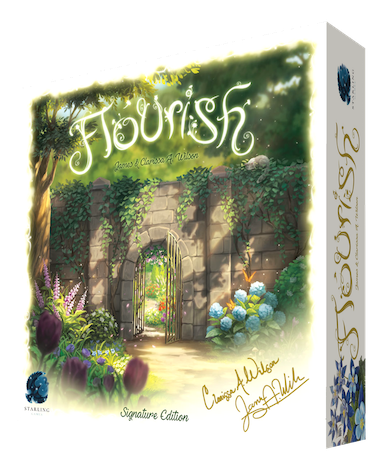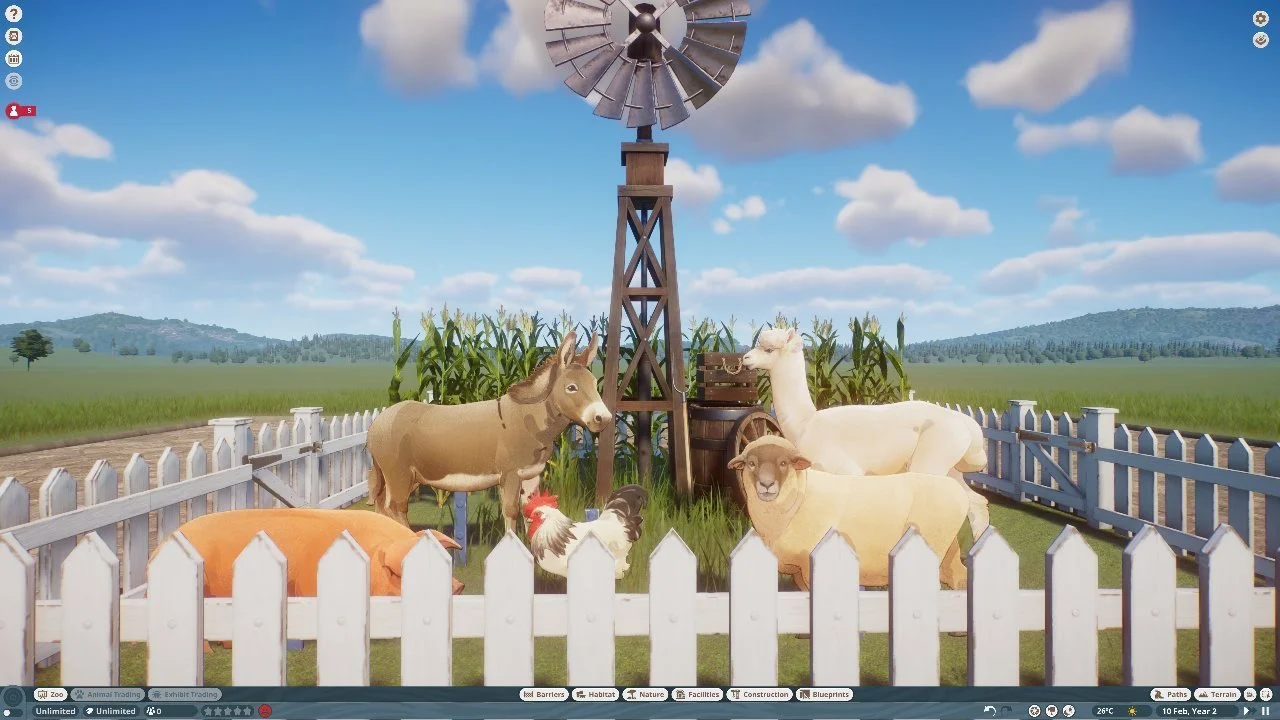Review copy provided by Starling Games
A War of Whispers is the latest board game from designer Jeremy Stoltzfus and publisher Starling Games. It’s a competitive tabletop strategy game for two to four players that simplifies the complexity and length of intricate area control games like A Game of Thrones into an approachable and fast-paced clash of warring kingdoms and shifting loyalties. Empires are at war, but they are not controlled by the players. Spymasters, religious sects, political power players, and savvy manipulators are vying for control in the world, and everyone has a secret agenda.
It’s a game of military poker, and players want to ensure they have the best hand by the conclusion of the final round.
Let’s start pulling on the puppet strings and see if A War of Whispers has what it takes to stay on the shelf as a go-to strategy game.
STORY
Five mighty empires are at war for the world. Their banners flying boldly, they march towards glory. The ferocity of the bear. The pride of the Lion. The endurance of the Horse. The reach of the Eagle. The power of the Elephant. Come the dawn, the world will be remade, and one empire will rule over them all…
But it is in the shadows that true power lies… a Serpent, a Spider, a Raven, a Rat. This is not a war for the mighty, with battles waged on the open field. This is a war fought by empires unseen—a war of whispers.
Imagine A Song of Ice and Fire or Game of Thrones if the narrative followed the political machinations and empire-breaking of Varys or Littlefinger.
If you don’t understand the fantasy references, imagine a conflict between neighboring kingdoms that descends into a bloody war as each one tries to take control over the known world. Then take a step back from the armies. And take a step back from the ruling class of the land. Retreat into the shadows and find the ones making life-or-death decisions miles from the battlefield.
It reminds me of Black Orchestra—another Starling Games strategy experience—in which players attempt plots to overthrow the Nazi regime and assassinate Hitler as members of the resistance. It’s a World War II game that doesn’t involve soldiers, combat, or normal military strategy.
A War of Whispers is an exciting subversion of expectation in strategy games, and the narrative focus shifts to a rarely explored realm of war.
GAMEPLAY
For 30 to 90 minutes, players will command armies to launch attacks into new regions and take control of cities, all while using cards to enhance their strategy and more fully influence the outcome of the war.
Each player will have some level of loyalty or interest in the five armies on the map. These loyalties will be randomly placed down on the player board and will determine the intensity with which they try to advance the agenda of any particular army.
For instance, a player might have the strongest allegiance to the Elephant empire, followed in descending order by the Eagle, Bear, Horse, and Lion empires. That starting placement will mean that the player wants the top three empires to expand and retain control of their territories while the bottom two empires shrink and lose ground.
But each empire has four actions that can be activated each round. The Sheriff, the Steward, the Marshal, and the Chancellor are all council positions in an empire that allows players to perform a particular action. That might be adding banners to the board in order to defend a location or in preparation for a later attack. That might be collecting cards from the empire’s deck to affect a later move. Or it might be attacking a particular region with the active empire’s troops in order to gain new territory.
These actions are what drives the gameplay, and they are decided upon by where players place their agents.
Here’s the order in a round of A War of Whispers:
1) Players, in clockwise order and one at a time, place their agents on available council positions.
2) Then the round tracker moves clockwise around the circular board, activating each council position in order, moving from one empire to another until all five empires have gone.
3) Then players discard excess cards from their hand.
4) At this point during the end of a round, players all have the opportunity to switch two unrevealed loyalty markers among the five in order to adjust their strategy and better reflect the state of the battlefield.
This is where the shifting loyalties come into play. Depending on their empire placement, players will score x4, x3, x2, x0, or x-1 for each city under the empire’s control at the end of the game. If the state of the game board starts to derail carefully laid plans, then players can act accordingly.
By the end of the game, players might all be vying for similar empires to succeed, though likely with different point values.
And once loyalty is revealed, it can’t be swapped again, so players force themselves to back a certain empire and everyone else will be aware of their allegiance.
It’s a clever mechanic that makes in-game strategy decisions have lasting effects, and it also creates an amusing atmosphere as players start to realize which empires each player is struggling to support.
A War of Whispers has some interesting strategy, but it’s also not an obtuse or needlessly complex game. It’s easy to teach to new players, and there are few moving parts. Five empires are on the board. Cities are what score points at the end of the game. And banners are the troops that empires use to defend and attack regions. Other than that, only two other map symbols affect gameplay. Farms influence the strength of armies that can be supplied in a single region and forts to help to defend locations as immovable structures. And both of these symbols also factor into the number of cards that players can draw depending on the active empire.
While the movement of troops and ordinary battles are the encounters that one might expect when nations collide, the cards are the mechanic that reflects the intrusion of meddling hands into the war. Played one at a time or in combination, they represent strong maneuvers and surprising events that would otherwise be impossible, and they can turn the tide of a battle, restore hope for a flagging empire, or provide unstoppable momentum if used at the right time.
It’s an addition that further enhances the theme of the game, and it makes the crafty gameplay of A War of Whispers all the more fun.
One element of the gameplay that merits attention is the idea that players are attacking and defending armies from the different empires, but they’re never targeting an actual player in the game. Since players hold a number of loyalties to different empires, they are never singled out by an attack or by a card played, and that’s important. There isn’t much of a chance for antagonistic attacks or animosity around the table. In lengthy strategy games like A Game of Thrones or Twilight Imperium, players can be eliminated from the competition after hours of investment, or reduced to an impotent presence while still forced to participate in the gameplay. It can be a debilitating experience, and A War of Whispers avoids that entirely by having players affect the board indirectly. It’s a smart design choice.
And it’s done in less than two hours. Which is hard to say for many strategy games.
All in all, it’s a great tabletop experience that’s simple enough to attract players of all kinds while still ensuring the kind of tactical depth that strategy lovers demand.
VISUALS
The deluxe edition of A War of Whispers does provide a higher level of quality to some of the components that improve the gaming experience. It’s not often that I would suggest starting off with a higher-priced version of the game, but I’ll explain my reasoning.
Replacing the cardboard agent tokens are plastic pieces that depict agents on thrones, and these pieces will be placed around the board on the empires’ council positions. Plastic components will definitely hold up better over time, but the best value is the plastic city pieces that are in the deluxe edition. These cover up the city map symbols, which blend in with the darker colors of the board. This is important because, without the plastic pieces, you might have to shift banners around and glance at the board frequently to make sure you know where the cities are on the map. That can be annoying to players if you’re trying to assess the state of the map without showing so easily where your interest lies.
With larger plastic pieces, you won’t have that issue as much. The metal first-player coin is a nice touch, but it doesn’t contribute at all to gameplay like the other updated components.
While the artwork on the game board does seem like an old map with hand-drawn elements, it can be vexing at times to shift banners around in order to count up the farms, forts, or cities. The symbols tend to blend in with the background art.
That can be remedied, though, by habitually placing banners in parts of the regions that are not near farms, forts, or cities. It’s a small irritant, but nothing that detracts from the overall gameplay.
REPLAYABILITY
A War of Whispers plays quickly. And while it’s easy to learn, players will learn new ways to manipulate actions and cards to elevate the status of empires or crush them. This means that the new strategy game from Jeremy Stoltzfus will be a frequent go-to choice for a game night if players want a lively game of manipulation.
WHAT IT COULD HAVE DONE BETTER
Two things:
The map symbols are sometimes hard to distinguish which can halt the game for a few moments while counting icons on a particular council position. I’ve already discussed it, though, and it’s a small concern.
The other issue is the lack of a FAQ section in the rulebook that might clarify questions about the rules during a game. The special actions on cards could be interpreted in multiple ways sometimes, and the inclusion of a full glossary of terms or something similar would have prevented any confusion.
VERDICT
A War of Whispers is an excellent game. I am impressed by the smart design choices and novel gameplay mechanics that innovate on the strategy genre by finding new ways to make area control and influence work in a competitive board game. If you enjoy complex strategy games but can’t get them on the table with your friends often enough, this would be a good compromise. If you’re looking for an engaging strategy game, but are scared off by the commitment and energy required to play the long military and political campaigns in other games, then A War of Whispers would be the perfect gateway game to test the tabletop experience.


























